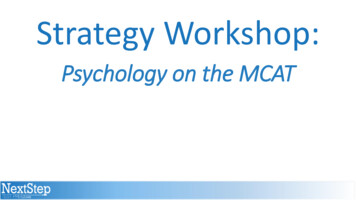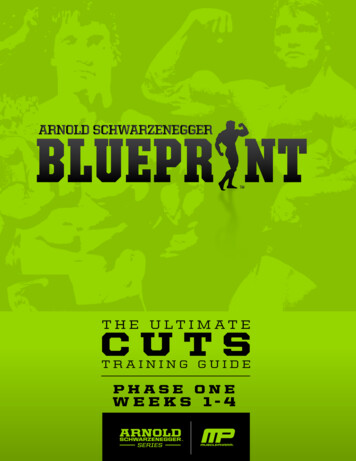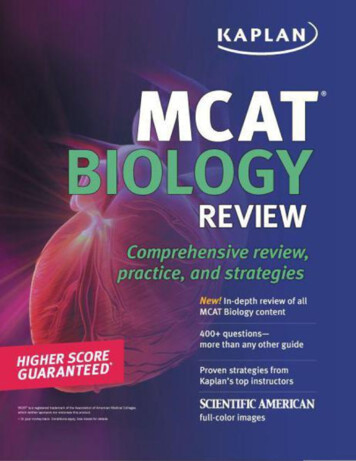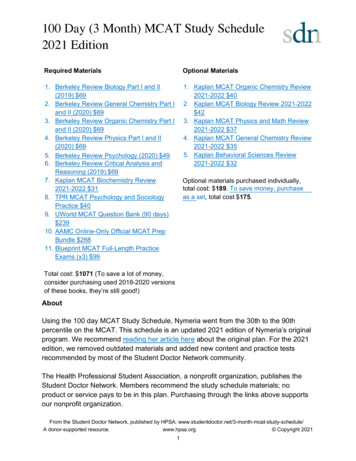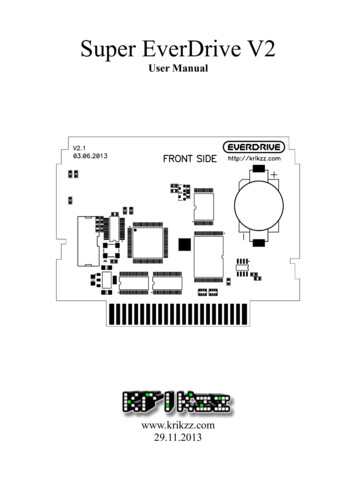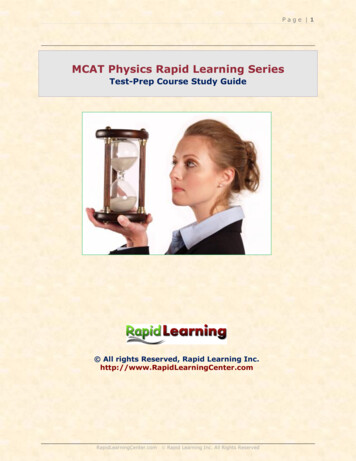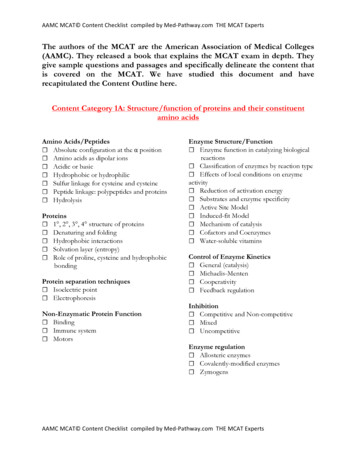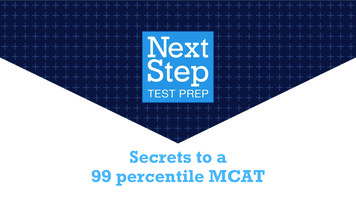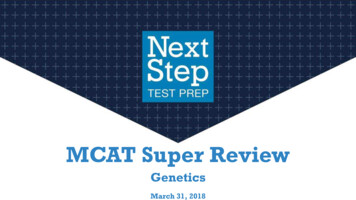
Transcription
MCAT Super ReviewGeneticsMarch 31, 2018
Welcome! If you haven’t been to one of ourwebinars before, here’s how it works. Eachsession is meant to be: Interactive Problem-focused Specific to your needs (so ask questions!) This is not just a lecture! You can benefitmost by: Is your microphone on and available? Can you find the hand-raise button? Can you find the Chat or Questions box? Let me know if you have technical issues! Raising your hand and speaking Asking questions in the chat boxSTUDENTS HAVE A CHOICE IN TEST PREP
Who Is Next Step? Began in 2009 as a tutoring company Focus on graduate admissions tests only Team of educational experts First company to have materials built fromground up for 2015 MCAT format Now the first company to have new 2018MCAT Interface We never stop improving our materials!STUDENTS HAVE A CHOICE IN TEST PREP
Who Am I? Clara Gillan Course Content Director at Next Step Senior instructor; 526 MCAT score Managed development of Next Step’supdated interface Written and edited thousands ofquestions
Biology Content ReviewCongrats on making progress through our MCAT course! Today let’s focus on bio: Overall study strategiesActive learningBig-picture perspectiveTest-like thinkingWhen studying, ask yourself Why does this matter for future physicians? Cell biology: How do structures contributeto the function of an organism? Genetics: How does a topic contribute toreal-world issues? What consequences woulddysfunction of a given system have? Physiology: How do all the pieces fit together? How does a system respond to changes in theenvironment? What would dysregulation cause? How does a system contribute to our ability tofunction?
DNA and RNA DNA deoxyribonucleic acid Monomer nucleotideWHAT IS YOUR NEXT STEP?
DNA and RNA RNA ribonucleic acidWHAT IS YOUR NEXT STEP?
DNA vs. RNA DNA Contains A, G, T, C Typically double-stranded Found in nucleus; storage molecule Sugar deoxyribose RNA Contains A, G, U, C Typically single-stranded Found in nucleus and cytoplasm; short-lived Sugar ribose Can catalyze reactions (ribozymes)WHAT IS YOUR NEXT STEP?
MCAT Question: DNA andRNA12. The most memorable difference between DNA and RNA relates to theircomposition. While thymine is a building block in DNA, it is replaced byuracil in RNA. Which of the following is another functional differencebetween DNA and RNA?A) The genome of viruses is exclusively made up of DNA.B) The inherent instability of RNA molecules renders them unable to storegenetic information.C) Certain RNA molecules possess the ability to catalyze biochemicalreactions, while DNA molecules cannot.D) RNA molecules, unlike DNA, are incapable of hydrogen bonding.
MCAT Question: DNA andRNA1. What is a major difference between the human genome and that ofE. coli?A) The human genome contains 106 base pairs, while that of E. colicontains 109.B) The genome of E. coli contains many more extraneous segments ofDNA than the human genome.C) The E. coli genome is contained within a few chromosomes, whilethe human genome is composed of 46.D) The human genome includes multiple chromosomes, while that ofE. coli is composed of a single circular chromosome.WHAT IS YOUR NEXT STEP?
Transcription: An Overview DNA mRNAdouble-strandedA, C, G, Tstored in nucleussingle-strandedA, C, G, Urapidly degrades Initiation RNA polymerase II binds promoter DNA is unwound Role of transcription factors?Images adapted from BruceBlaus. Blausen.com staff. "Blausen gallery 2014". Wikiversity Journal ofMedicine. DOI:10.15347/wjm/2014.010. ISSN 20018762 under CC BY 3.0
Transcription: An Overview Elongation RNA polymerase travels 3’5’(adds nucleotides 5’ 3’) DNA re-winds after RNA pol passes Termination RNA pol reaches termination site, detachesexonsImage adapted from Thomas Shafee under CC BY-SA 4.0introns
Transcription: A Common Pointof Confusion Only one strand is transcribed Antisense strand (not both!)is transcribed AKA template strand, noncoding strand Complementary to product mRNA Sense strand is NOT transcribed AKA coding strand, nontemplate ’reverse transcription5’-ATGCCGA-3’ Identical to product mRNA (except U vs T) A segment of mRNA is transcribed from a dsDNA molecule in which the antisense strandis 5’-ATGCCGA-3’. The mRNA strand is then reverse transcribed. What will be thesequence of the cDNA immediately produced?“complementary” DNA
Post-TranscriptionalModifications Location of transcription: Location of translation:nucleusribosomes in cytosol /bound to rough ER But where do the modifications take place? Three main events1. Addition of a 5’ methylguanosine cap2. Addition of a 3’ poly-A tail3. Splicing of introns and ligation of exons “Pre-mRNA” hnRNAheteronuclear
5’ Capping First: how can the 5’ end bedistinguished?2’ –OH ribose5’-5’ triphosphate linkageguanosine “5’ free phosphate” Capping begins beforetranscription ends Protects from enzymaticdegradation in cytosol7-methyl“enzymes that act on”ribonucleasesRNAImage adapted from Fdardel under CC BY-SA 3.0WHAT IS YOUR NEXT STEP?
3’ Polyadenylation How can the 3’ end be distinguished? “3’ free -OH”addition of 200 Polyadenylation adenine residues Enzyme-catalyzed DNA polymerase? no! “Polynucleotide adenyltransferase” Two main functions Binding site for nuclear export protein Protects from degradation at 3’ end Longer tail more time before degradation
Last But Not Least: Splicing Exons coding Introns noncoding Present in pre-mRNA Not present in mature mRNA Do prokaryotic genomes include introns?
Splicing Mechanism Spliceosome Large RNA-protein complex Assembles on hnRNA transcript Recognizes intron-specific sequences snRNAs small nuclear RNAs snRNA protein snRNPsmall nuclear ribonucleoprotein Afterward, exons ligatedImage adapted from OpenStax College under CC BY 3.0lariat shape
Alternative Splicing # of human genes (estimated): 20,000 # of human proteins (estimated): How is this possible? Alternative splicing Introns are still spliced out BUT so are some exons! Remaining exons are ligated One geneup to 1,000 proteins! 200,000
MCAT Question: PostTranscriptional Modifications4. The human genome contains a large number of repetitive sequencesthat have no known function. What happens to these sequences during thelife of a cell?A) These sequences are removed during meiosis to prevent theirinheritance by the next generation.B) These sequences are translated, but the proteins that they code for areimmediately destroyed.C) These sequences are spliced out before transcription takes place.D) The sequences are spliced out before translation takes place.
MCAT Question: PostTranscriptional Modifications11. A spliceosome is a complex structure assembled from snRNAs and theirassociated proteins. If an organism was suddenly unable to producespliceosomes, what would be the likely result?A) Transcription of mRNA from DNA would no longer occur.B) The dysfunctional machinery would severely limit DNA replication.C) The organism would produce mRNA identical to pre-mRNA.D) The recombination of different exons would not occur, limiting thediversity of gene products.
DNA Packagingproteins around which dsDNA “Histones” windshistoneproteins Help form a compact structure Core octamer complex “Nucleosome” histone complex wound DNA “Beads on a string” 5 distinct histone proteins in human cells Core: H2A, H2B, H3, H4 Linker: H1nucleosome 2Image adapted from Darekk2 under CC BY-SA 3.0Image adapted from Mariuswalter under CC BY-SA 4.0
Forms of Chromatin Euchromatin Loose structure Appears light under a light microscope Promotes transcriptional activity When would this form dominate?S phase (DNAreplication) Heterochromatin Compact structure, appears dark under lightmicroscope Represses transcriptional activity When would this form dominate?mitosis (chromosomescondense)Images adapted from Annabelle L. Rodd, Katherine Ververis, and Tom C. Karagiannis under CC BY-SA 1.0
Histone Modificationspost-translational As proteins, histones can undergo modification Acetylation, deacetylation, phosphorylation Histones alkaline (basic) positive ( ) Phosphates on DNA negative Acetylation Catalyzed by histone acetyltransferase Removes ( ) chargeDecreases histone-DNA attraction loose conformation
Histone Modifications Deacetylation Catalyzed by histone deacetylase Increases ( ) charges presentIncreases histone-DNA attraction compact laseImages adapted from Annabelle L. Rodd, Katherine Ververis, and Tom C. Karagiannis under CC BY-SA 1.0
MCAT Question: DNAPackaging2. The correct sequence of DNA packaging in chromosomes, from thesmallest component to the most complete form, is:A) double-stranded DNA chromatin histones nucleosomes.B) double-stranded DNA histones nucleosomes chromatin.C) chromatin double-stranded DNA histones nucleosomes.D) chromatin double-stranded DNA nucleosomes histones.WHAT IS YOUR NEXT STEP?
PCR – Why Do We Use It? PCR polymerase chain reaction Amplification of a sequence of interest Like DNA replication in the lab! First, some terms to understand: Hybridization Denaturation Annealing(“melting”)
PCR “Ingredients” Taq polymerase Why not a eukaryotic polymerase? DNA oligonucleotides primers DNA sample of interestdeoxynucleotide dNTPs triphosphates Proper bufferImage adapted from I, Madprime under CC BY-SA 3.0Thermus aquaticus
PCR Method: RepetitiveCycles1. Denaturation (95 C)this breaks thedsDNA!2. Annealing (50-65 C)why such awide range?3. Extension (72 )4. Repeat!
Restriction Enzymes Also known as restriction endonucleases Used to make recombinant DNA Leave “sticky ends” Why? Rejoined by DNA ligaseEcoRI recognition sequencecleavesphosphodiesterbond
Example: RestrictionEnzymes Which of these likely serves as a recognition sequence for a restrictionenzyme? A geneticist wishes to ligate two fragments of bacterial DNA that arecurrently found in separate plasmids. He should first: cut both plasmids with the same restriction enzyme. cut both plasmids with different restriction enzymes. either of the above; it doesn’t matter.
DNA Librariesbacterial plasmid / virusthat “holds” the fragment Many DNA fragments stored in “vectors” Allows fragments to be kept for later use Genomic library Restriction digest cDNA librarycontains all DNA from an organismligation into vectortransfectioncontains complementary DNA mRNA obtained reverse transcribedw/ DNA polymerase(nointrons!)made into dsDNA
Sanger Sequencing Older technique (1977) 4 test tubes with these “ingredients”: ssDNA template (what we’re sequencing) A polymerase enzyme A DNA primerddATPin all 4 tubes High [] of 4 dNTPs (dATP, dTTP, etc.) Low [] of 4 labeled ddNTPs (ddATP,ddTTP, etc.)one ddNTP in each tubeWHAT IS YOUR NEXT STEP?
Sanger Sequencing Replication occurs in each tube What happens when a ddNTP is incorporated?replication terminateshappens many times in eachtube! Why must [dNTPs] [ddNTPs]?Image adapted from Abizar at en.wikipedia under CC BY-SA 3.0
Next Step:Core ValuesWe are dedicated to providing personalized support,advice and prep options that match each student’sindividual needs.STUDENTS HAVE A CHOICE IN TEST PREP
Students Havea Choice Over 50,000 students have used Next Step TestPrep in their MCAT Prep journey Always up-to-date content, strategy and tests Guaranteed Satisfaction Expert instructors on call for you No call center – instead, Academic Managers guide you allthe way!
PersonalizedOptions No matter your study style, subjectexpertise, or MCAT goal, Next Step has anoption for your personal needs andlifestyle. Self-Prep Materials and Planning Guided Online Study with Free Extra Help Flexibility and Personalization One-on-One Tutoring
Next Step:Educate Every Day Use this high-value FREE practice tobuild a study plan suited to your goals,needs, and schedule.Industry’s Best Free MCAT Practice Bundle Half-length MCAT diagnostic Full-length MCAT exam 450 Question Science Content Diag exam Test Review Videos Multiple QBank Samples 16 Test & 4 Content Review Videos Proprietary Study Plan Generator Aligned to new MCAT 2018 InterfaceSign up for our FREEPractice Bundle:nextsteptestprep.com/mcat-resources-page
AdditionalFree Resources Supplement your prep with additional support tools Question of the Day Quick Prep YouTube, Facebook and Instagram Content Ongoing Public Webinars and Q&A Sessions MCAT Blog: Content and Admissions Next Step MCAT Forum
New 2018 MCATInterface New Highlighting featuresNew Strikethrough featuresNew Keyboard ShortcutsNew Navigation/Review ScreensNext Step is ready. Are you? Your practice experience matters! Prep with the most realistic testingenvironment with Next Step.
Take the Best Next Step Others say it. We deliver it. Most up-to-date Lesson Review Books in 4-color QBank with passage and discrete question types Exclusive Study Plan Generator personalized foryou Hundreds of hours of videos Private, small-group Office Hours 5 days a week Direct access to MCAT Content Team Affordable prep options: from books to tutoring
MCAT Study Options Best-in-Class MCAT Tutoring Packages Variety of packages: Crash Course to EliteChoices include our MCAT Online CoursePersonalized Study Plan for each studentTop-scoring tutors Most up-to-date MCAT Course All new books in 4-color, all online AAMC resources10 full-length exams aligned to new interfaceLive online office hours for any Q&A held 5 days perweekStudy Plan Generator to match each student’sstrengths, weaknesses and schedule needs MCAT Practice Test Bundles Available in 4-, 6-, and 10-pack bundlesAll aligned to new 2018 interface
Get Solid Advice for Your Next StepSchedule a one-on-one consultation with an Academic Manager.REQUEST IN TODAY’S WEBINAR SURVEY.
Questions?
Industry’s Best Free MCAT Practice Bundle Half-length MCAT diagnostic Full-length MCAT exam 450 Question Science Content Diag exam Test Review Videos Multiple QBank Samples 16 Test & 4 Content Review Videos Proprietary Study Plan Genera
